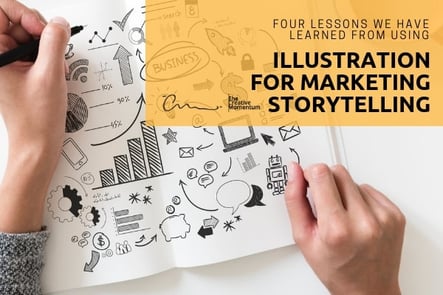 The power of storytelling is taking hold in the marketing world, and for good reason—it works. As humans, we’re predisposed to love a good story. They resonate in our minds and teach us about ourselves.
The power of storytelling is taking hold in the marketing world, and for good reason—it works. As humans, we’re predisposed to love a good story. They resonate in our minds and teach us about ourselves.
In service of this, companies are gearing their marketing towards storytelling across all fronts—web design, social media, email marketing, and more. And in our experience as a web design firm, we've noticed that one particular strategy can yield great results in this respect: Illustrations!
As our clients have built their websites and seen the benefits of illustrations in action, we’ve learned several key principles that we’d like to share, complete with some great examples of companies that have it right.
1. Illustrations Tell the Story of Your Brand
Your brand is unique, and so are your products. No two services are exactly the same, and your company needs to find an inventive way to explain what differentiates you from the competitors. Storytelling is a great way to do this.
Of course, stories shouldn’t be limited to text. A picture is worth a thousand words, after all, and the right combination of graphics and illustrations can be a powerful way to provide information to your audience.
Just look at email marketing provider MailChimp for a good example. The homepage is a prime example of a strategic use of strong typography, white space, and balance—but there's more going on than meets the eye. Look at the splashes of color and abstract shapes layered throughout the page.
The combination of dashboard illustrations, color, and shapes help introduce the user to the MailChimp brand and their brand story.
MailChimp’s strategy is to simplify email marketing; to make a somewhat dry marketing practice come to life. (It’s no coincidence that they include such vibrant colors to drive this point home!)
Unlike other email marketing providers with stuffy homepages, walls of text, and “we’re so serious” business photography, MailChimp highlights its accessible nature through the use of illustrations and provides a wealth of information about the company’s laid-back culture.
2. Illustration is a Friendly Way to Introduce Users to Your Product
First impressions are everything. This is particularly true in website design, where customers make value judgments about the quality of your brand within the first few seconds of visiting. With that in mind, we've found that illustrations tend to make a great first impression when introducing users to new products.
For this, let’s look at file storage company Dropbox. Just like MailChimp, Dropbox leverages a laid-back and abstract artistic style to show off the creativity of its brand. But Dropbox has one advantage over MailChimp in this regard: Its service is a heck of a lot easier for the layperson to understand. As such, it’s able to use simple illustrations to introduce new users to the service and gently explain how it works.
It’s hard to imagine a time when something like cloud storage was still a revolutionary concept, but part of the reason why so many consumers are familiar with it is because leaders like Dropbox made the process accessible to the tech-illiterate. If you want the full story of how Dropbox’s distinctive style came to be, this rundown written by Dropbox Illustration Lead Michael Jeter is a great read.
Suffice to say, Dropbox’s designers knew from its earliest days that its illustrations had to connect with readers and teach them about how cloud storage worked. In short, to tell the story of the service and introduce them to a new world. And obviously, their strategy paid off.
3. Illustrations Excel at Showing Users the Ins and Outs of the Service
A good use of illustrations is to introduce various parts of the user interface and showcase how the service works. Again, this is particularly important for software companies with somewhat abstract services that can benefit from including visual elements.
From a marketing standpoint, this type of explanation helps users visualize how the service looks, how easy it is to use, and the benefits they’ll find from it. For this example, let’s look at payment processor Stripe.
Stripe does a good job of using illustrations to tell a story—in this case, the story of how to leverage its integrations, dashboards, and features to improve your business. The site provides this information in a clean and simple layout. Its color palette works well with its illustrations and provides clear distinctions of its on-site elements.
The site also does a good job of integrating friendly icon illustrations with on-site animations to create a calm and simple style, much like Dropbox. But what’s great about this style is that the company still comes across as professional despite its playful tone. Their messaging is focused, accessible, and appealing to both consumers and B2B audiences.
While not exactly a story, this strategic website design provides deep psychology cues to readers and creates a brand image that doesn’t need to be explained.
4. Stock Illustrations Can Be a Powerful Tool
Don’t underestimate the power of stock images, photos, or illustrations for storytelling. While some view them as nothing more than an inexpensive workaround for custom images, you don’t have to start with a blank slate to create great illustrations that support your brand’s messages.
Here’s how it works. Start by storyboarding your design and lining out the main points of the story you want to tell. From there, use stock illustration and stock photography sites to find images containing elements that fit the bill.
Then, you can take each illustration, extract the components you want, and combine them with elements taken from other images. Finally, composite them together into an entirely new image that maintains the look and feel of your brand. This process is simple, effective, and saves you the hassle of having to hire an on-staff illustrator.
For an example of how the end result might look, look at messaging application Slack.
(Note—we’re not sure if these are custom illustrations or not, but they highlight our point all the same. Just go with us here.)
Slack’s illustrations are simple and effective. They highlight the brand’s relaxed identity and make it clear that the service supports friendly, effortless office communication. But Slack doesn’t use complicated visuals to get these ideas across. Its playful illustrations almost seem like stock drawings, but it’s clear that they’re focused and deliberately constructed to push the company’s value. Use this as an example of how simple graphical elements can be combined to create unique brand messaging.
Illustrative Storytelling
Overall, consider illustrations a friendly and lighthearted way to approach your brand’s storytelling. You can use them to set expectations, reinforce your brand’s values, and introduce people to new ideas—all without significant investment in creative assets.
Are illustrations right for every brand? Of course not—but for the brands with the right story to tell, they’re an effective tool for connecting with readers in a friendly and professional way.


